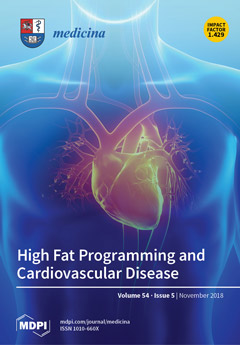Background and objectives: Chronic kidney disease (CKD) increases the risk of cardiovascular diseases even in its early stages and is associated with structural and functional cardiac abnormalities. The aim of this study was to use speckle-tracking echocardiography (STE) to evaluate left and right ventricle mechanics and function, markers of subclinical dysfunction in patients with end-stage renal disease (ESRD) undergoing haemodialysis.
Methods: Patients with ESRD undergoing regular haemodialysis and with preserved left ventricle (LV) ejection fraction (EF) (
n = 38) were enrolled in this retrospective study. The control group consisted of 32 age-matched persons with normal kidney function (glomerular filtration rate (GFR) >90 mL/min/1.73 m
2 according to Chronic Kidney Disease Epidemiology Collaboration (CKD-EPI)). Conventional 2D echocardiography and STE were performed in all patients.
Results: 70 individuals, 31 (44.29%) males and 39 (55.71%) females, were included in the study. There were no significant differences in age, sex and body surface area between the groups. LV end diastolic diameter did not differ between the groups, while LV myocardial mass index was higher in the group of patients on haemodialysis (111.64 ± 27.99 versus 84.21 ± 16.99,
p < 0.001) and LV diastolic dysfunction (LVDD) was found in 31 (81.6%) patients of this group. LV global longitudinal strain (GLS) (−22.43 ± 2.71 versus −24.73 ± 2.03,
p < 0.001) and LV global circumferential strain (GCS) at the mitral valve and papillary muscles levels (−18.73 ± 3.49 versus −21.67 ± 2.22,
p < 0.001; −18.64 ± 2.75 versus −20.42 ± 2.38,
p = 0.005, respectively) were significantly lower in haemodialysis group patients. The parameters of the right ventricle (RV) free wall longitudinal function including RV GLS (−22.63 ± 3.04 versus −25.45 ± 2.48,
p < 0.001), were reduced in haemodialysis patients compared with the controls. However, RV fractional area change (FAC) did not differ between the groups (
p = 0.19).
Conclusion: Patients with ESRD and preserved LV ejection fraction undergoing haemodialysis had a higher prevalence of LVDD and impaired LV longitudinal and circumferential deformation indices, as well as reduced RV longitudinal function and deformation parameters compared with the age-matched healthy controls. STE helps to detect subclinical LV and RV dysfunction in chronic haemodialysis patients.
Full article






